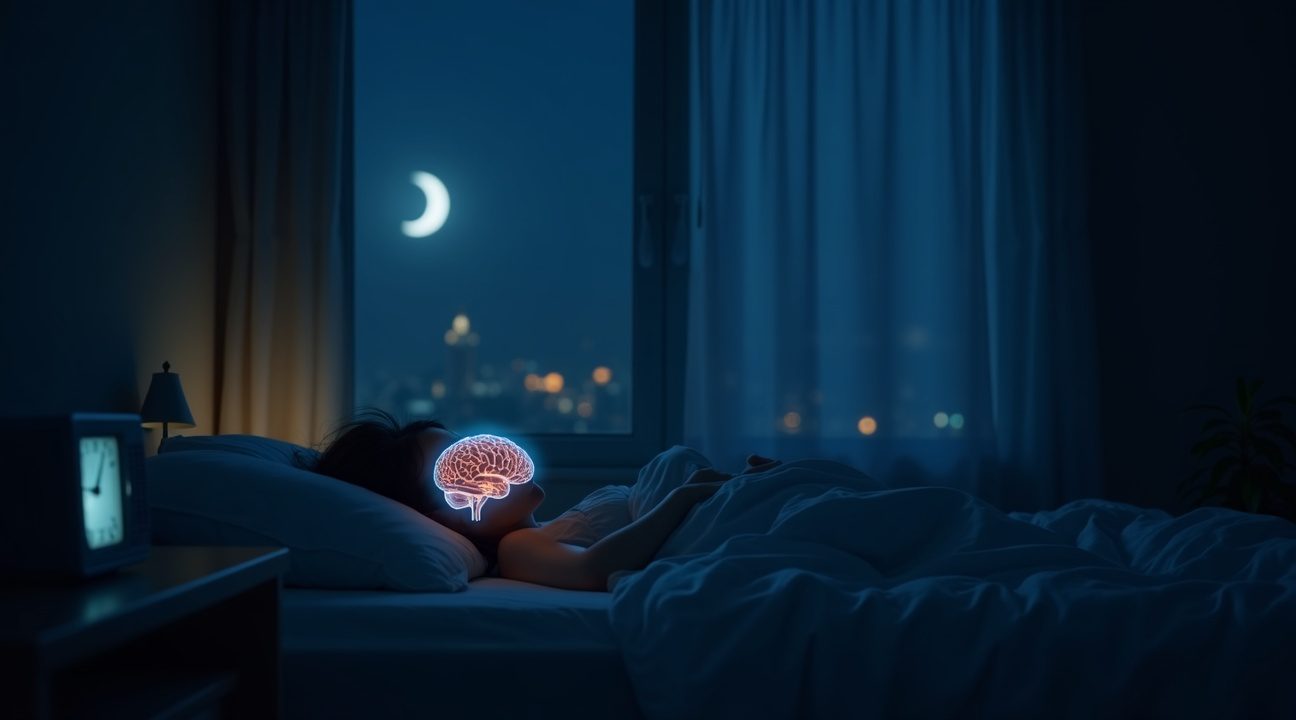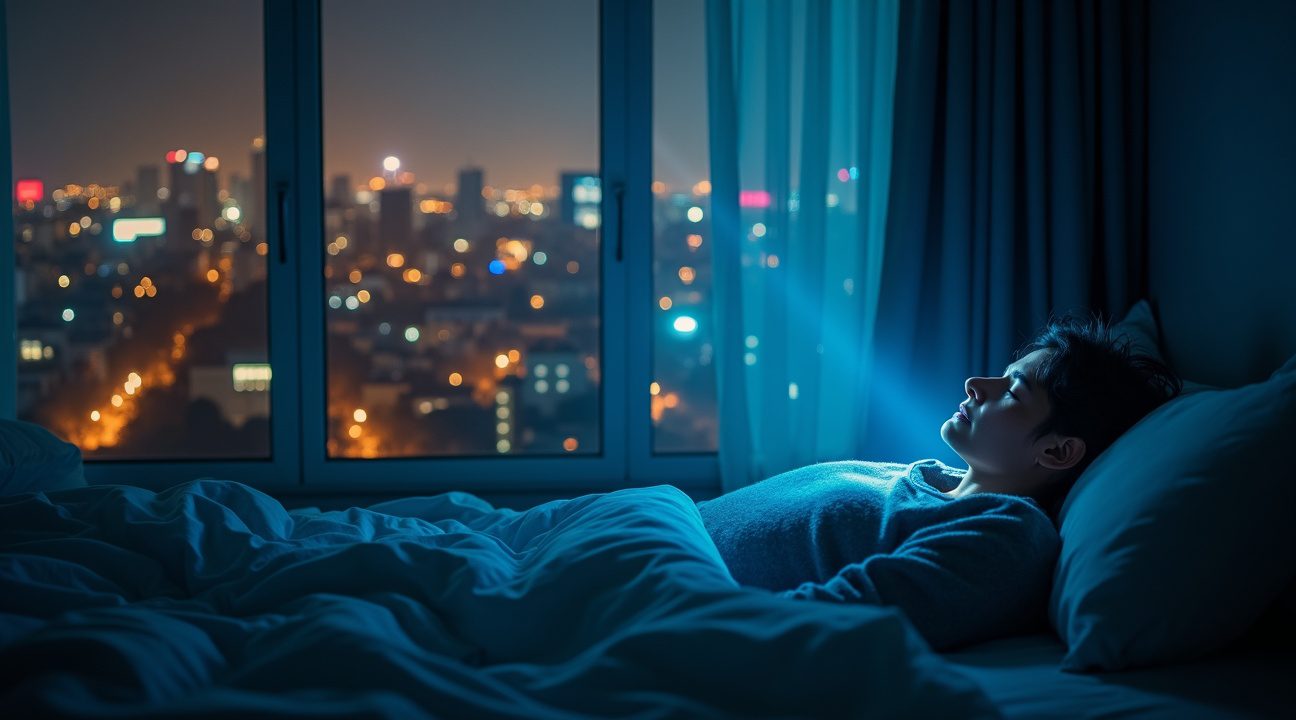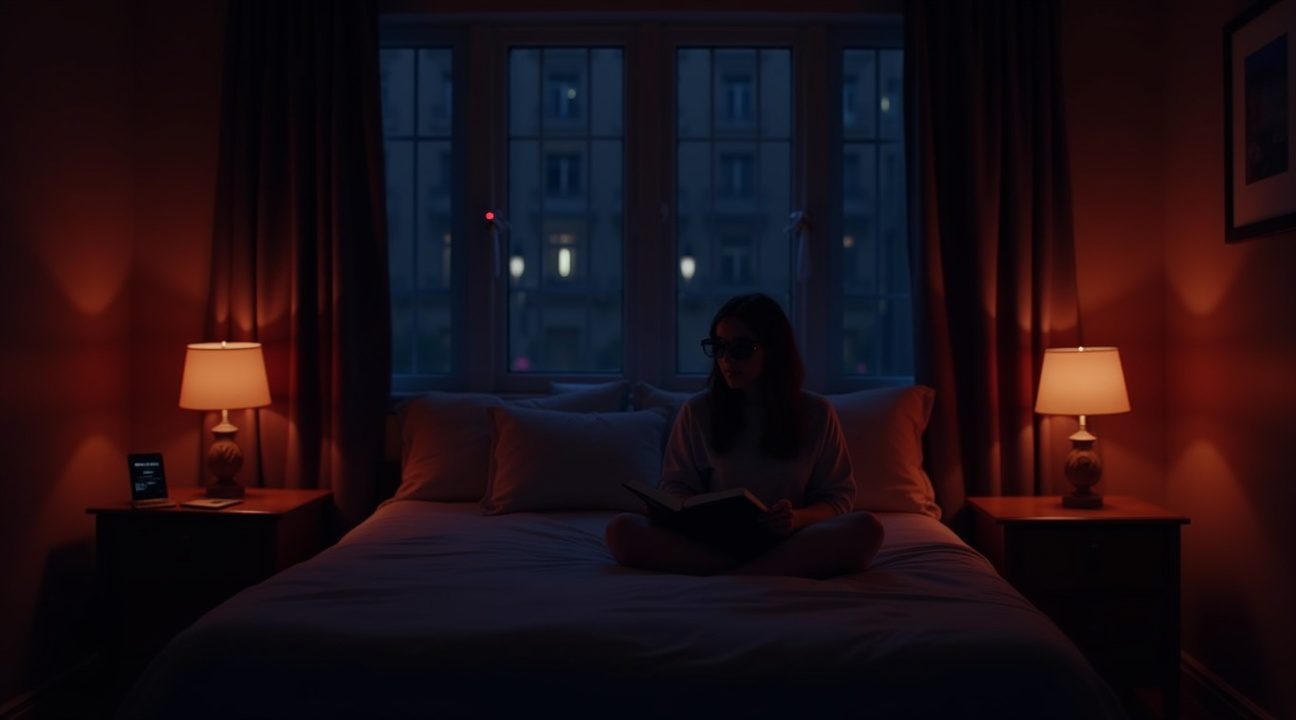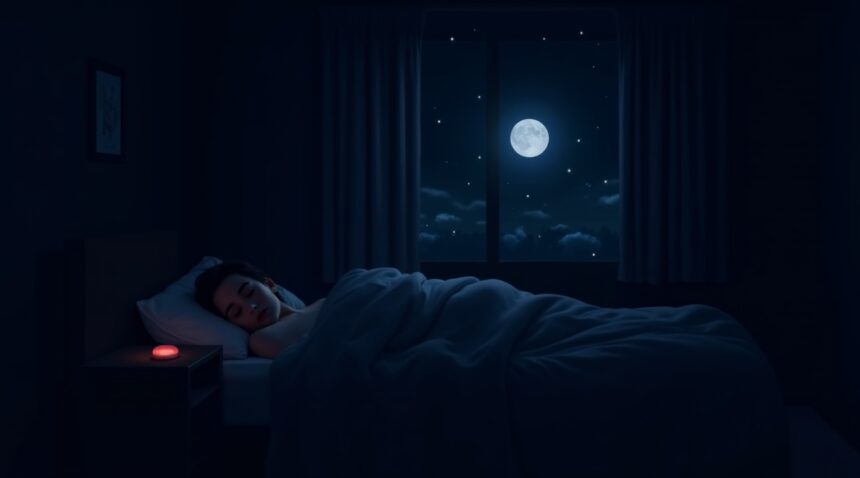A groundbreaking study reveals that exposure to as little as 40 lux of light during sleep—equivalent to a dim night light or bright moonlight—significantly disrupts the brain’s essential recovery processes and memory consolidation functions.
This research challenges widely held assumptions about safe bedroom lighting and shows that even minimal light exposure at night can negatively impact melatonin production, alter sleep patterns, and impair the brain’s ability to clear metabolic waste during rest—all crucial for cognitive and physical restoration.
Key Takeaways
- Even 40 lux of light during sleep can significantly impair brain recovery, reduce melatonin levels, and lead to lighter sleep with more frequent night awakenings.
- Children and teenagers are more vulnerable due to still-developing circadian rhythms, meaning nighttime light can have stronger and potentially lasting impacts on their neural development and emotional health.
- Everyday sources of light—such as digital alarm clocks, the glow from electronic devices, or streetlights entering through curtains—often surpass the 40 lux threshold that disrupts sleep architecture.
- Chronic exposure to nighttime light can contribute to long-term health issues, such as mood disorders, impaired metabolism, elevated cardiovascular risk, and a potential rise in cancer susceptibility.
- Protective changes to your sleep environment—including using blackout curtains, reducing screen exposure an hour or two before bed, and opting for warm, dim lighting—can help restore natural circadian rhythm and improve sleep quality.
Creating a Sleep-Friendly Environment
1. Limit Light Sources in the Bedroom
Turn off or cover electronic device standby lights, and consider using analog clocks instead of digital ones. Small adjustments can keep your sleep space below the 40 lux threshold noted in the study.
2. Opt for Warm-Toned Lighting
Use dim, amber-colored lights in the evening to avoid stimulating the brain with blue light, which significantly disrupts melatonin production. Warm-toned LEDs or salt lamps can be excellent alternatives.
3. Reduce Outdoor Light Intrusion
Installing blackout curtains or blinds can block ambient light from street lamps or passing cars that might otherwise filter into your room and interfere with your sleep cycle.
4. Establish a Wind-Down Routine
Avoid screens at least 1–2 hours before bedtime and engage in relaxing activities like reading a physical book or meditating to naturally cue your body for rest.
Ultimately, this study shines new light on just how sensitive the human brain is to environmental cues, even at levels previously thought harmless. By making small but significant adjustments to your nighttime space, you can safeguard both your sleep and long-term health.
Even 40 Lux Can Shatter Your Brain’s Nightly Recovery
Sleep experts have long known that light can interfere with rest, but recent research reveals just how sensitive our brains are to even minimal illumination. I’ve found that many people underestimate the impact of what seems like harmless ambient lighting during sleep hours.
The 40 Lux Threshold That Changes Everything
Study participants exposed to as little as 40 lux during sleep experienced significant disruptions to their brain’s recovery processes. This level of brightness equals what you’d experience from a dim night light or the glow of a bright full moon streaming through your window. The researchers discovered that this seemingly innocent amount of light triggered measurable changes in sleep architecture.
Participants showed shallower sleep patterns and increased nighttime arousals compared to those sleeping in complete darkness. Brain oscillations associated with memory consolidation and cognitive function dropped markedly during sleep periods. These oscillations play a crucial role in transferring information from short-term to long-term memory and clearing metabolic waste from brain tissue.
The study also revealed suppressed melatonin production in participants exposed to the low-level lighting. Melatonin serves as an essential hormone for sleep onset and sleep phase regulation. When production gets disrupted, people experience longer periods trying to fall asleep and wake up with reduced morning alertness.
Real-World Implications for Sleep Quality
These findings challenge common assumptions about what constitutes acceptable bedroom lighting. Many households maintain various light sources that exceed 40 lux without realizing the impact on brain potential during rest. Digital clocks, electronic device standby lights, street lamps filtering through curtains, and bathroom night lights can all contribute to this threshold.
I recommend conducting a simple assessment of your sleep environment. Check for any sources of illumination that might be disrupting your brain’s natural recovery cycle. Consider blackout curtains, eye masks, or repositioning electronic devices to eliminate unnecessary light exposure. Even small adjustments can make a significant difference in sleep quality and cognitive function.
The research emphasizes that your brain requires complete darkness to achieve optimal rest and recovery. Sleep methods used by military personnel often prioritize environmental control precisely because of these physiological requirements. Light pollution in bedrooms has become increasingly common as our homes fill with more electronic devices and urban environments grow brighter.
Temperature regulation also works in tandem with light exposure to influence sleep quality. Your body naturally cools down as melatonin production increases, but light exposure can interfere with this process. Creating an environment that supports both darkness and appropriate temperature gives your brain the best chance for restorative sleep.
The study’s implications extend beyond individual sleep quality to broader health concerns. Chronic exposure to light during sleep hours may contribute to long-term cognitive decline, memory problems, and metabolic dysfunction. Sleep disruption has been linked to various health conditions, making environmental control an important preventive measure.
Consider implementing a gradual light reduction routine in the hours leading up to bedtime. This approach helps your body’s natural circadian rhythms prepare for sleep while supporting healthy melatonin production. Dim lighting in the evening signals to your brain that sleep time approaches, making the transition to complete darkness more effective.
Professional sleep specialists increasingly recognize light exposure as a critical factor in sleep hygiene protocols. The 40 lux threshold provides a concrete benchmark for evaluating bedroom environments and making targeted improvements. Small changes in your sleep environment can yield substantial improvements in how rested and alert you feel each morning.

How Light Hijacks Your Internal Clock at the Worst Possible Time
Artificial light during nighttime hours creates chaos within your circadian clock, the internal biological system that orchestrates sleep-wake cycles with remarkable precision. This clock operates through the suprachiasmatic nucleus (SCN) in your brain, which responds to light signals as primary Zeitgebers – environmental cues that synchronize your body’s rhythms. Even minimal light exposure can throw this delicate system off balance when it encounters illumination at inappropriate times.
The Phase Response Curve Reveals Critical Timing Windows
Your circadian system responds differently to light depending on when exposure occurs, following what scientists call the Phase Response Curve (PRC). Morning light exposure advances your sleep cycle, essentially pushing your internal clock forward and making you wake earlier. Conversely, nighttime light exposure delays your circadian timing, shifting your natural bedtime later and disrupting the recovery process your brain desperately needs.
This timing sensitivity explains why quality sleep becomes compromised when light infiltrates your sleeping environment. Your SCN interprets late-night illumination as a signal to stay alert, effectively hijacking the natural progression toward restorative sleep phases. The system evolved over millions of years to respond to natural light patterns, not the constant artificial illumination that characterizes modern life.
Blue Light and Melatonin Suppression Create Perfect Storm
Blue-enriched light from screens, LED bulbs, and electronic devices proves particularly disruptive to your circadian rhythm. This wavelength triggers powerful melatonin suppression, blocking the production of your body’s natural sleep hormone. However, the disruption doesn’t require intense blue light exposure – even brief or dim light can shift your circadian timing significantly.
Your melatonin production typically begins rising in the evening as darkness falls, preparing your brain for sleep. When artificial light interrupts this process, several problems emerge:
- Delayed sleep onset as your brain receives mixed signals about appropriate bedtime
- Reduced overall melatonin production affecting sleep quality throughout the night
- Shifted circadian phase that misaligns your internal clock with your desired sleep schedule
- Fragmented sleep patterns that prevent proper brain restoration cycles
The sensitivity of this system means that even small amounts of light can create measurable effects. Street lights filtering through curtains, smartphone notifications, or digital clock displays all contribute to circadian disruption. Your brain interprets these light sources as environmental cues to maintain alertness, directly opposing the natural sleep drive that builds throughout the day.
Understanding these mechanisms helps explain why sleep specialists recommend complete darkness during sleep hours. Your circadian system can’t distinguish between intentional and accidental light exposure – it simply responds to photons hitting specialized cells in your retina. These cells connect directly to your SCN, creating an immediate pathway for light to influence your internal clock.
Modern sleep environments often contain multiple light sources that weren’t present during human evolution. Each source represents a potential disruption to your circadian rhythm, particularly when exposure occurs during critical windows outlined by the Phase Response Curve. Even if you manage to fall asleep despite light exposure, the quality of that sleep suffers as your brain struggles to complete essential restoration processes while fighting against circadian confusion.
The solution involves recognizing that your internal clock operates as a precision instrument requiring specific environmental conditions. Just as structured sleep approaches can improve rest quality, controlling light exposure during sleep hours helps maintain proper circadian function. Your SCN needs consistent darkness signals to coordinate the complex biological processes that occur during different sleep stages, making light control a critical component of sleep hygiene.
The Hidden Health Crisis Lurking in Light Pollution
Light pollution presents a serious threat that extends far beyond disrupted sleep patterns. The artificial glow from streetlights, billboards, and urban infrastructure creates a cascade of health problems that researchers are only beginning to fully understand.
Chronic Health Consequences of Nighttime Light Exposure
Exposure to light during nighttime hours triggers multiple physiological disruptions that compound over time. The most significant impacts include:
- Metabolic dysfunction that affects how the body processes glucose and regulates insulin
- Mood disorders, particularly depression, which develop as circadian rhythms become increasingly unstable
- Elevated cardiovascular risk due to disrupted stress hormone cycles
- Potentially increased cancer risk as cellular repair processes become compromised during disrupted sleep cycles
Multiple epidemiological studies reveal alarming patterns among populations living in brightly lit urban areas. People residing in high light pollution zones consistently report significantly less sleep, more frequent insomnia episodes, and excessive daytime sleepiness compared to those in darker environments. This chronic sleep deprivation creates a domino effect that impacts nearly every aspect of physical and mental health.
The cognitive toll proves equally concerning. Poor sleep quality resulting from nighttime light exposure severely impairs concentration abilities and memory formation processes. I’ve observed that individuals struggling with sleep quality issues often experience reduced mood stability, creating cycles where mental health deteriorates alongside physical wellness.
Light pollution doesn’t discriminate based on socioeconomic status or geographic location. Urban dwellers face constant exposure to artificial illumination that penetrates bedroom windows, while suburban residents contend with increasingly bright streetlights and commercial lighting. Even rural areas aren’t immune, as sky glow from distant cities can travel surprising distances.
The metabolic consequences deserve particular attention. When artificial light disrupts natural circadian rhythms, the body’s internal clock struggles to coordinate essential processes like hormone production and cellular repair. This disruption affects insulin sensitivity, leading to increased diabetes risk and weight management difficulties.
Depression rates show strong correlations with light pollution levels across multiple studies. The brain’s production of melatonin and regulation of serotonin become compromised when exposed to artificial light during crucial rest periods. These neurochemical imbalances contribute to persistent mood disorders that often resist traditional treatment approaches.
Memory consolidation, which occurs primarily during deep sleep phases, suffers tremendously under artificial light exposure. The brain requires complete darkness to effectively transfer information from short-term to long-term storage, making concentration and learning increasingly difficult for those experiencing chronic light pollution exposure.

Why Children and Teens Face the Greatest Risk from Nighttime Light
Developing Brains Show Heightened Vulnerability
Young minds face a particularly challenging situation when exposed to light during sleep hours. Animal model research reveals the dramatic impact that even minimal light exposure can have on developing neural systems. Studies conducted on chicks demonstrate that just one hour of nighttime light can significantly disrupt the release of crucial hormones needed for proper brain development.
The research highlights two key hormones that suffer from light interference: melatonin and allopregnanolone (ALLO). These hormones play essential roles in neural growth and development, and their disruption during critical developmental windows can create lasting effects. Scientists have observed that changes in hormone patterns from nighttime light exposure may persist well into adulthood, suggesting that childhood light exposure habits could influence lifelong brain function.
Age-Related Sensitivity Creates Unique Challenges
Children and adolescents demonstrate significantly higher sensitivity to nighttime light compared to adults. This heightened vulnerability stems from their rapidly developing circadian systems and ongoing neural maturation processes. The brain’s natural ability to produce adequate melatonin and ALLO requires consistent darkness signals, which become even more critical during periods of rapid growth.
Research indicates that people with mood disorders also show increased sensitivity to light during sleep hours. This finding suggests a connection between emotional regulation systems and light exposure that becomes particularly relevant for teenagers, who already experience natural fluctuations in mood and emotional processing. Understanding brain potential requires recognizing how environmental factors like light can impact developing minds.
The implications extend beyond immediate sleep quality. Hormone disruption during formative years can affect attention span, emotional regulation, and cognitive development. Parents and caregivers need to understand that what might seem like harmless ambient light from electronic devices, streetlights, or nightlights could interfere with critical developmental processes occurring during sleep.
Creating optimal sleep environments for young people means eliminating even small sources of light that adults might easily ignore. Blackout curtains, eye masks, and removing electronic devices from bedrooms become essential strategies for protecting developing brains from unnecessary light exposure during their most vulnerable growth periods.
Simple Changes That Can Rescue Your Sleep From Light Invasion
I’ve discovered that protecting your sleep from light disruption doesn’t require expensive renovations or complicated gadgets. Small adjustments to your environment can create the darkness your brain needs for proper rest.
Blackout curtains stand as your first line of defense against external light sources. These specially designed window coverings block streetlights, early morning sun, and neighbor’s security lights that can penetrate regular curtains. Unlike standard drapes, blackout curtains use multiple layers or special coatings to achieve near-complete darkness. I recommend measuring your windows carefully and choosing curtains that extend beyond the frame to prevent light leakage around the edges.
Electronic screens pose another significant threat to quality sleep. The blue light emitted by phones, tablets, and televisions can suppress melatonin production for hours after exposure. I suggest establishing a digital sunset routine by powering down all screens 1–2 hours before bedtime. This practice allows your brain to begin its natural wind-down process without interference from stimulating blue wavelengths.
For those who can’t completely avoid screens during evening hours, blue light filters offer a practical compromise. Most modern devices include built-in settings that automatically warm the screen temperature as evening approaches. Third-party apps and physical blue light blocking glasses provide additional options for minimizing exposure. Unlocking brain potential becomes much easier when you eliminate these disruptive light sources.
Creating Melatonin-Friendly Lighting
Smart lighting choices throughout your evening routine can support your body’s natural sleep preparation. These adjustments help maintain your circadian rhythm while still providing necessary illumination:
- Replace bright white bulbs with dim, warm-toned alternatives in bedrooms and bathrooms
- Install red-toned night lights for safe navigation without melatonin suppression
- Use table lamps instead of overhead lighting during the two hours before bed
- Consider smart bulbs that automatically adjust color temperature based on time of day
- Position reading lights to minimize direct eye exposure while maintaining functionality
Ambient lighting requires careful consideration of both timing and intensity. I find that gradually reducing light levels throughout the evening signals to your brain that sleep time approaches. Start dimming lights around sunset, then continue reducing brightness every hour until bedtime. This gradual transition mimics natural daylight patterns and supports healthy sleep hygiene practices.
The key lies in understanding that your brain interprets any light exposure as a signal to stay alert. Even small amounts of illumination from alarm clocks, charging cables, or hallway lights can interfere with deep sleep stages. Military sleep methods often emphasize creating completely dark environments for this exact reason. I recommend conducting a nighttime audit of your bedroom, identifying and eliminating every source of artificial light for optimal brain rest.

Sources:
National Institutes of Health (PMC) – “Timing of light exposure affects mood and brain circuits”
Sleep Foundation – “Light & Sleep: Effects on Sleep Quality”
PMC – “Effects of light on human circadian rhythms, sleep and mood”
NIOSH – CDC Archive – “Effects of Light on Circadian Rhythms”
eLife – “Brain Development: The impact of light during the night”
EurekAlert! – “How artificial light at night damages brain health and metabolism”
Nature Scientific Reports – “Light exposure behaviors predict mood, memory and sleep quality”
Nature Reviews Psychology – “effects of light on the circadian clock and mood-related behaviours”


